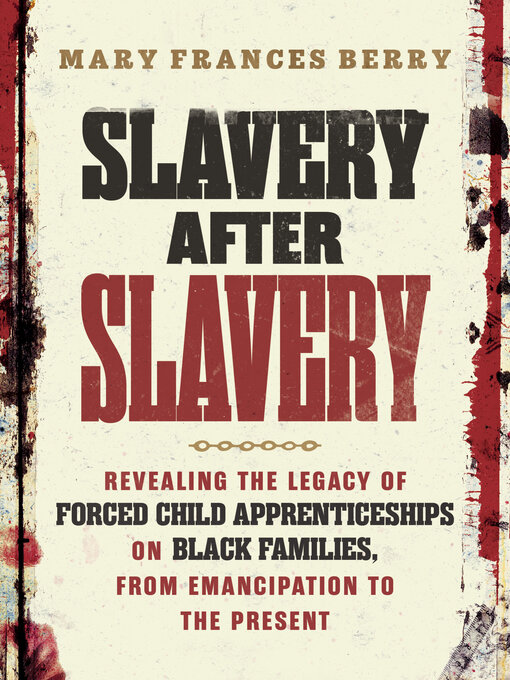Slavery After Slavery
Revealing the Legacy of Forced Child Apprenticeships on Black Families, from Emancipation to the Present
While the Thirteenth Amendment abolished slavery, white southerners established a system of apprenticeship after the Civil War that entrapped Black children and their families, leading to undue hardships for generations to come. In Slavery After Slavery, historian Mary Frances Berry traces the stories behind individual cases from southern supreme courts to demonstrate how formerly enslaved families and their descendants were systemically injured through white supremacist practices, perpetuated by the legal system.
By filling in the family trees of formerly enslaved people to their descendants, Berry documents the intergenerational harm they experienced. The resulting damage of trafficking Black children through apprenticeship laws has been a largely overlooked source of inequality, yet these cases provide specific examples of the kind of economic and physical harm Black families have endured.
Slavery After Slavery tells individual stories, but the fates of their descendants tell our collective American story—contributing powerfully to a case for reparations and restorative justice.
-
Creators
-
Publisher
-
Release date
January 21, 2025 -
Formats
-
Kindle Book
-
OverDrive Read
- ISBN: 9780807007846
-
EPUB ebook
- ISBN: 9780807007846
- File size: 1961 KB
-
-
Languages
- English
-
Reviews
-
Publisher's Weekly
Starred review from November 25, 2024
In this eye-opening and disturbing account, historian Berry (History Teaches Us to Resist) reveals that Black children were routinely “trafficked” by white Southerners via so-called apprenticeships following the Civil War. Through archival sleuthing, she uncovers a pattern of court cases in which Black parents tried to retrieve children stolen by wealthy whites, like the Alabama couple Nathan and Jenney Cox, who in 1865 lost five of their children—ages ranging from three to 16—to Francis Jones, their former enslaver. Jones—whom Berry characterizes as wanting “to keep his unpaid laborers as long as possible”—had applied to a court to indenture the children on the grounds that their parents could not support them, and that by granting his application the county would be spared the cost of their upkeep. The judge, a former Confederate officer, ruled in his favor, rejecting Nathan and Jenney’s protests that they were able to provide for their family. Other chapters recount similarly harrowing episodes that highlight additional cudgels used by the courts to traffic Black children, like how marriages that Black people had entered into during slavery were not considered legal, making their children legally orphans. Tracing the impact such forced separations had on later generations of these same families, Berry makes a forceful case for reparations. The result is a persuasive look at how the material harms of racism are still quantifiable today. -
Library Journal
February 21, 2025
The 13th Amendment to the U.S. Constitution in December 1865 outlawed slavery and involuntary servitude, but in fact it ended neither. Continued human trafficking, appropriated, exploited, and forced Black labor, along with manipulated law, subverted the substance and spirit of emancipation to perpetuate Black people's economic and social subordination, Berry's (emeritus, history and social thought; Univ. of Pennsylvania; History Teaches Us To Resist) new book demonstrates. The 10 chapters focus on the destruction of Black families whose children were snatched away through apprenticeship systems that desperate white Southerners contrived to perpetuate their control of Black labor. Through case studies, Berry shows the resistance, resilience, successes, and failures of these lost, stolen, or strayed Black families, along with those who managed to maintain extended ties through generations into the late 20th century. The palpable, systematic harm to familial bonds, personal relationships, and economic prospects have had intergenerational effects that helped racial inequality to persist. Seeing and understanding such continuing, demonstrable effects further illuminate questions about reparative justice and reparations for the identifiable descendants of the people who were enslaved, Berry concludes. VERDICT With its data-filled appendix, this instructive inquiry into post-Civil War U.S. history beckons readers to see what can be learned from tracing survivors of ongoing injuries from white supremacy's extensions of slavery.--Thomas J. Davis
Copyright 2025 Library Journal, LLC Used with permission.
-
Formats
- Kindle Book
- OverDrive Read
- EPUB ebook
subjects
Languages
- English
Loading
Why is availability limited?
×Availability can change throughout the month based on the library's budget. You can still place a hold on the title, and your hold will be automatically filled as soon as the title is available again.
The Kindle Book format for this title is not supported on:
×Read-along ebook
×The OverDrive Read format of this ebook has professional narration that plays while you read in your browser. Learn more here.


